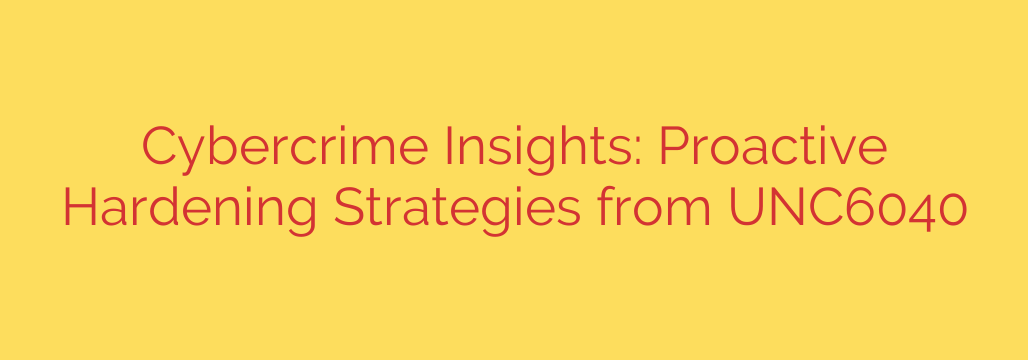
Lessons from the Dark Side: How Advanced Hackers Harden Their Own Servers
In the relentless cat-and-mouse game of cybersecurity, defenders are constantly looking for an edge. We analyze attacker tools, study their malware, and trace their digital footprints. But what if one of the most powerful lessons came not from how they attack, but from how they defend?
Recent insights into the operations of a sophisticated cybercriminal group reveal a startling level of discipline in their own operational security. These threat actors don’t just find weaknesses; they are experts at eliminating them from their own infrastructure. By studying their server hardening techniques, we can adopt a proactive, attacker-minded approach to our own defenses.
If criminals go to these lengths to protect their temporary, disposable servers, it sets a clear—and high—benchmark for protecting your critical business assets. Here are the key strategies they use and what you can learn from them.
Fortifying the Digital Perimeter: Firewall and Port Management
One of the first actions these threat actors take when deploying a new server is to lock down the firewall. They operate on a principle of “deny by default,” ensuring that no traffic is allowed unless it is explicitly required for their operation.
Using tools like Uncomplicated Firewall (UFW) on Linux systems, they immediately block all incoming connections and then carefully open only the specific ports necessary for their tools, such as SSH for remote access or a custom port for command-and-control (C2) traffic.
- Actionable Tip: Implement the principle of least privilege for your network. Regularly audit your firewall rules to ensure no unnecessary ports are open to the internet. Every open port is a potential doorway for an attacker, so close any that are not absolutely essential for business functions.
Mastering Access Control: Beyond Basic Passwords
Stolen or weak credentials remain a leading cause of security breaches. Advanced attackers know this better than anyone, which is why they rarely rely on simple passwords to protect their own infrastructure.
Instead, they immediately disable password-based authentication for SSH access. Their primary method of entry is through the use of SSH keys, which are far more difficult to brute-force or steal than a conventional password. Furthermore, they often disable direct root login, forcing any administrative access through a less privileged user account first. This adds another layer of security and creates a clearer audit trail.
- Actionable Tip: Mandate the use of SSH keys for all administrative access to your servers, especially those exposed to the internet. Disable direct root login and enforce strong, unique passwords for all user accounts where password authentication is still necessary.
Erasing the Footprints: Meticulous Log and History Wiping
For a cybercriminal, anonymity and evasion are paramount. To prevent security researchers or law enforcement from analyzing their methods, they are meticulous about covering their tracks. This involves systematically wiping command history files (like .bash_history) and clearing system logs that could reveal their activities.
They often use custom scripts or built-in commands to overwrite and delete log files and command histories before abandoning a server. This practice makes forensic analysis incredibly difficult, as the evidence of their presence is effectively erased.
- Actionable Tip: While attackers wipe logs to hide, you must do the opposite to ensure visibility. Implement a centralized, tamper-resistant logging solution. By forwarding logs from your critical systems to a separate, secure server (or a SIEM platform), you ensure that even if an attacker gains control of a machine and wipes local logs, the evidence has already been preserved elsewhere.
Automating Security with Precision
To ensure consistency and speed, these threat actors don’t perform these hardening steps manually every time. They rely on automated deployment scripts that configure a new server with their exact security specifications within minutes.
This scripted approach ensures that every piece of their infrastructure is hardened to the same high standard, minimizing the risk of human error or a forgotten security step. From setting firewall rules to disabling passwords and creating user accounts, the entire process is standardized and ruthlessly efficient.
- Actionable Tip: Adopt an “Infrastructure as Code” (IaC) mindset. Use configuration management tools like Ansible, Puppet, or Terraform to create automated, repeatable, and secure server deployment processes. This not only improves your security posture but also increases efficiency and reduces the risk of misconfiguration.
The Final Takeaway: Adopt an Adversarial Mindset
The operational security of a sophisticated threat actor is a powerful lesson in defensive strategy. Their approach is proactive, disciplined, and built on a foundation of assuming they are a constant target.
If these are the measures criminals take to protect temporary assets, your organization’s standards for protecting permanent, high-value data must be even higher. By adopting these same hardening principles—locking down firewalls, strengthening access controls, securing logs, and automating security—you can move from a reactive defensive posture to a proactive one, making your systems a much harder target for even the most determined adversaries.
Source: https://cloud.google.com/blog/topics/threat-intelligence/unc6040-proactive-hardening-recommendations/








